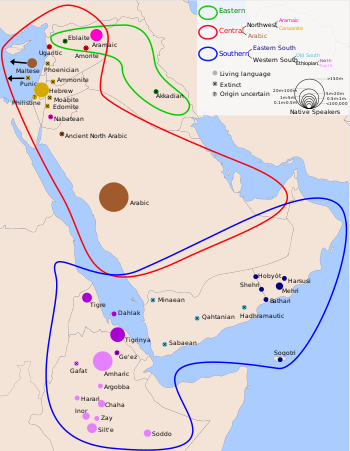South Semitic languages
| South Semitic | |
|---|---|
| Geographic distribution | Yemen, Oman, Ethiopia, Eritrea |
| Linguistic classification | Afro-Asiatic
|
| Subdivisions |
|
| Glottolog | None |
Approximate historical distribution of South Semitic languages | |
South Semitic is a putative branch of the
Western Asia
.
History
The "homeland" of the South Semitic languages is widely debated, with sources such as A. Murtonen (1967) and
Bayesian model to estimate language change concluded that the latter viewpoint is more probable.[3] This statistical analysis could not estimate when or where the ancestor of all Semitic languages diverged from Afroasiatic but it suggested that the divergence of the East, Central, and South Semitic branches occurred in the Levant.[4] According to many scholars nowadays, Semitic originated from an offshoot of a still earlier language in North Africa and desertification made some of its speakers migrate in the fourth millennium BC into what is now Ethiopia, others northwest into West Asia [5]
Classification
South Semitic is divided into two uncontroversial branches:[6]
- Western
- Old South Arabian – possibly extinct, formerly believed to be the linguistic ancestors of modern South Arabian Semitic languages, modern South Arabian now being classified as Eastern South Semitic. The Razihi language and Faifi languageare probably descendants.
- Ethiopian Semitic (Ethio-Semitic, Ethiosemitic, Ethiopic) on the southern coast of the Arabian Peninsula and found across the Red Sea in the Horn of Africa, mainly in modern Ethiopia and Eritrea.
- Eastern
- Dhofar).
Demographics
The Ethiopian Semitic languages collectively have by far the greatest numbers of modern native speakers of any Semitic language other than
liturgical language for the Orthodox Tewahedo
churches.
Southern Arabian languages have been increasingly eclipsed by the more dominant Arabic (also a Semitic language) for more than a millennium. Ethnologue lists six modern members of the South Arabian branch and 15 members of the Ethiopian branch.[7]
See also
References
- ^ Bender, L. (1997). "Upside Down Afrasian". Afrikanistische Arbeitspapiere. 50: 19–34.
- ISBN 9780719011238.
- PMID 19403539.
- PMID 19403539.
- ^ The Origin of the Jews: The Quest for Roots in a Rootless Age By Steven Weitzman page 69
- ^ Faber, Alice (1997). "Genetic Subgrouping of the Semitic Languages". In Hetzron, Robert (ed.). The Semitic Languages. Routledge. pp. 3–15.
- ^ "South". Ethnologue. Retrieved 2017-07-04.

